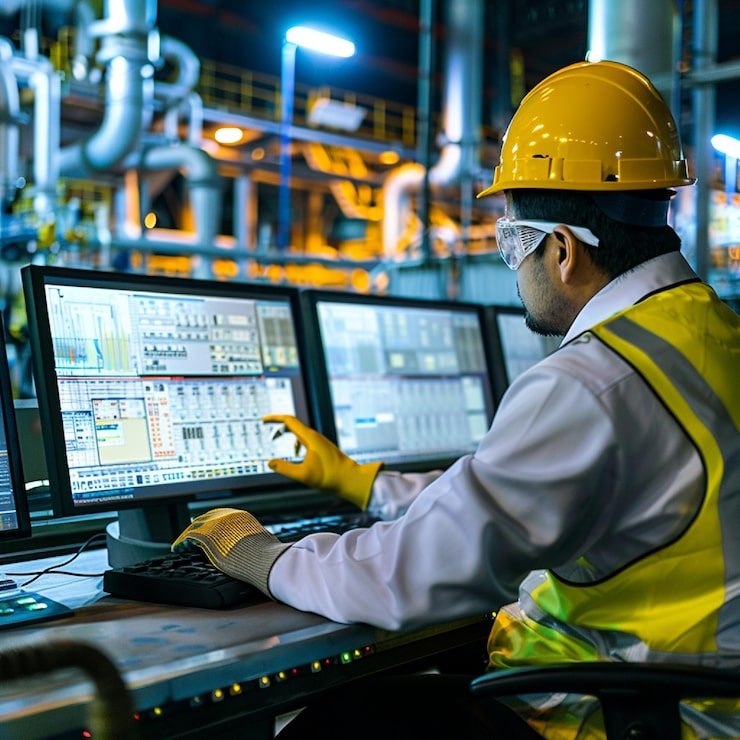In today’s fast-paced, technology-driven industrial landscape, staying ahead requires more than just efficient machinery or skilled teams. Modern industries must embrace real-time insights, predictive analytics, and intelligent automation to maintain operational excellence. This is where industrial monitoring solutions play a pivotal role. These systems integrate advanced sensing technologies, connectivity, and software intelligence to help organizations monitor performance, detect issues early, and make data-backed decisions that lead to smarter operations.
From manufacturing and energy plants to logistics, oil and gas, water treatment, and chemical facilities, industries depend heavily on precision, safety, and efficiency. With equipment and processes becoming increasingly complex, traditional monitoring methods no longer suffice. Smart monitoring systems have emerged as a powerful tool for ensuring uptime, reducing costs, and driving long-term productivity.
In this comprehensive guide, we’ll explore the evolution, key components, benefits, and future trends of industrial monitoring solutions—and how organizations can leverage them to transform their operations.
Understanding Industrial Monitoring Solutions
Industrial monitoring solutions refer to a combination of hardware and software technologies designed to track, analyze, and manage industrial processes in real time. These systems gather data from different points across production floors, machinery, pipelines, devices, and environmental conditions to give operators a clear picture of performance.
At their core, these solutions revolve around three simple ideas:
- Data Collection – Sensors, smart meters, and connected devices capture data on temperature, vibration, pressure, speed, energy use, flow, and other parameters.
- Data Analysis – Advanced analytics, AI, and machine learning evaluate patterns, detect abnormalities, and identify hidden inefficiencies.
- Actionable Insights – Dashboards, alerts, and automated responses ensure timely intervention, preventing downtime or damage.
This continuous loop of monitoring, analyzing, and adjusting leads to operations that are not only efficient but also predictive and self-correcting.
Why Industrial Monitoring Solutions Matter Today
Modern industries face several pressing challenges: rising energy costs, strict compliance requirements, labor shortages, aging equipment, and increasing competition. In such an environment, having greater visibility and control over operations is no longer optional—it’s essential.
Here’s why these solutions have become indispensable:
- Minimizing Downtime
Unplanned downtime can cost companies thousands—or even millions—per hour. Industrial monitoring solutions provide early warnings when equipment shows signs of failure, allowing timely maintenance rather than reactive repairs.
- Enhancing Safety
Industries dealing with chemicals, high temperatures, pressure systems, or volatile materials rely on monitoring systems to maintain safe limits. Alerts ensure operators can act before issues escalate.
- Improving Energy Efficiency
Monitoring electricity consumption, machine load, waste heat, and airflow helps facilities reduce operational costs and meet sustainability goals.
- Ensuring Compliance
Industrial environments must adhere to stringent regulations. Monitoring systems help maintain accurate records and consistent performance for audits and certifications.
- Boosting Productivity
By identifying bottlenecks, optimizing workflows, and reducing errors, industrial monitoring solutions enhance overall productivity and throughput.
Key Components of Advanced Industrial Monitoring Solutions
To understand how these systems truly work, let’s break down their essential components.
- Smart Sensors
Sensors are the backbone of any monitoring system. They measure real-time parameters such as:
- Temperature and humidity
- Pressure and flow
- Vibration and acoustic signals
- Gas levels and emissions
- Energy consumption
- Machine performance metrics
With IoT-enabled sensors, data is transmitted instantly for processing.
- Edge Devices
Edge computing devices process data locally before sending it to the cloud. This reduces latency and improves real-time decision-making.
- Industrial IoT Platforms
IoT platforms consolidate data from various sensors and machines. They provide:
- Dashboards
- Trend analysis
- Automated alerts
- Remote monitoring functionalities
- Cloud Computing
The cloud enables large-scale storage, advanced analytics, and machine learning integration for performance forecasting and optimization.
- AI and Machine Learning Algorithms
AI and ML detect anomalies, predict equipment failure, and recommend corrective actions, making operations smarter and more autonomous.
- Actuators and Control Systems
Some industrial monitoring solutions are integrated with automation systems that take action without human intervention—for example, shutting down a machine overheating.
Types of Industrial Monitoring Solutions
Depending on the nature of operations, industries implement various monitoring solutions such as:
- Condition Monitoring
Tracks mechanical health indicators like vibration, temperature, and lubrication.
- Environmental Monitoring
Ensures safe working conditions by tracking air quality, humidity, lighting, and chemical exposure.
- Energy Monitoring
Helps optimize power usage, reduce waste, and lower utility bills.
- Asset Monitoring
Provides real-time visibility into the performance and availability of critical equipment.
- Process Monitoring
Tracks workflow parameters, production rates, and quality metrics for consistent output.
- Structural Monitoring
Used in factories, warehouses, and energy plants to evaluate fatigue, strain, or vibration in buildings and infrastructure.
Benefits of Implementing Industrial Monitoring Solutions
Adopting smart monitoring offers long-term advantages:
- Predictive Maintenance
Instead of waiting for breakdowns, industries can predict when machines need care. This approach extends equipment lifespan and reduces repair costs.
- Enhanced Product Quality
Monitoring ensures consistent quality by preventing issues that may affect production.
- Real-Time Decision Making
With accurate, up-to-date data, operators respond faster and smarter to evolving conditions.
- Cost Efficiency
By reducing downtime, energy waste, and manual intervention, industries achieve higher profitability.
- Scalability
Modern monitoring platforms scale easily as facilities grow or operations expand.
- Remote Accessibility
Managers can monitor performance from anywhere, improving flexibility and oversight.
Applications Across Multiple Industries
Industrial monitoring solutions are transforming practices across various sectors:
Manufacturing
Machine health tracking, robotic monitoring, and workflow optimization.
Energy & Utilities
Monitoring wind turbines, solar plants, power grids, and pipelines.
Oil & Gas
Tracking pressure changes, leak detection, pipeline monitoring, and gas emissions.
Water Treatment
Supervising flow, contamination levels, pH balance, and equipment performance.
Food & Beverage
Ensuring temperature control, hygiene standards, and quality consistency.
Pharmaceuticals
Maintaining sterile environments, air purity, and precise manufacturing conditions.
How to Choose the Right Industrial Monitoring Solutions
Selecting the ideal system depends on your industry, budget, and goals. Consider:
- Process needs (What exactly must be monitored?)
- Scalability (Will the system grow with your facility?)
- Integration capability (Does it work with existing systems?)
- Data security features
- User-friendly dashboards and reporting
- AI-driven analytics capabilities
Consulting with a trusted solutions provider ensures you invest in a system tailored to your operations.
Future of Industrial Monitoring Solutions
As industries continue digital transformation, monitoring systems will grow more powerful. Key trends include:
- AI-driven autonomous monitoring
- Digital twins that simulate industrial environments
- 5G-enabled faster data communication
- Sustainability-focused energy monitoring
- Advanced cybersecurity layers for industrial IoT
The future clearly lies in smart, interconnected, and automated operations.
Final Thoughts
Industrial monitoring solutions are no longer optional but essential for businesses striving for efficiency, safety, and competitiveness. With real-time insights, predictive intelligence, and enhanced control, industries can dramatically improve uptime, reduce costs, and ensure consistent performance.
By embracing advanced monitoring technologies today, companies lay the foundation for smarter, more resilient, and future-ready operations.




